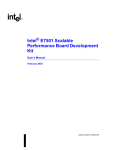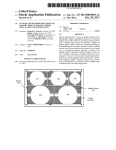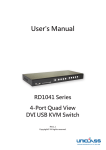Download USER'S MANUAL - Pdfstream.manualsonline.com
Transcript
GA-8IPXDR-E Series Intel® Dual XeonTM Serverboard USER’S MANUAL Intel® Dual Xeon Processor Serverboard Rev. 1001 25A08-08IPX-F00 GA-8IPXDR-E(C) Motherboard Table of Content Item Checklist ......................................................................................... 4 GA-8IPXDR-E Series Model List ........................................................... 4 WARNING! ............................................................................................... 4 Chapter 1 Introduction ............................................................................. 6 Features Summary ...................................................................................... 6 GA-8IPXDR-E(C) Motherboard Layout ....................................................... 8 Chapter 2 Hardware Installation Process ................................................ 9 Step 1: Install the Central Processing Unit (CPU)..................................... 10 Step 1-1: Installing Motherboard to the Chassis... ....................................................... 10 Step 1-2: CPU Installation ................................................................................................ 11 Step 1-3: CPU Heat Sink Installation ............................................................................. 13 Step 2: Install memory modules ................................................................ 15 Step 3: Install expansion cards ................................................................. 17 Step 4: Connect ribbon cables, cabinet wires, and power supply ........... 18 Step 4-1: I/O Back Panel Introduction ............................................................................ 18 Step 4-2: Connectors Introduction .................................................................................. 20 Step 4-3: Jumper Setting Introduction ............................................................................ 30 Chapter 3 BIOS Setup .......................................................................... 36 Main ........................................................................................................... 38 Advanced ................................................................................................... 41 Advanced Configuration .................................................................................................. 42 Chipset Configuration ...................................................................................................... 44 Power Management Configuration ................................................................................. 45 PCI-X Configuration ........................................................................................................ 46 Peripheral Configuration .................................................................................................. 47 Security ...................................................................................................... 54 Boot ............................................................................................................ 56 Exit ............................................................................................................. 58 2 Table of Content Chapter 4 Technical Reference ............................................................ 60 GA-8IPXDR-E System Block Diagram ..................................................... 60 Chapter 5 Appendix ............................................................................. 61 Appendix A: Intel Network Driver Installation ............................................................... 61 Appendix B: INF Update Installation (Driver for chipset) ............................................. 63 Appendix C: ATI Rage XL VGA Driver Installation ...................................................... 64 Appexdix D: Adaptec SCSI Driver Installation ............................................................ 65 Appendix E: Utilites Installation ...................................................................................... 66 Appendix F: About Updateing Latest version of BIOS ................................................ 66 Appendix G: IPMI Connector Pin Definition .................................................................. 67 Appendix H: Acronyms .................................................................................................. 68 Technical Support/RMA Sheet ....................................................................................... 70 3 GA-8IPXDR-E(C) Motherboard Item Checklist ; The GA-8IPXDR-E series motherboard ; I/O Back Panel ; IDE cable x 1/ Floppy cable x 1 ; Driver CD for motherboard driver & utility ; ; USB Cable x 1(Optional) SCSI Cable x 1 (Optional) ; GA-8IPXDR-E user’s manual GA-8IPXDR-E Series Model List GA-8IPXDR-E (Supports 533MHz / with SCSI function) GA-8IPXDR-EC (Supports 533MHz / without SCSI function) 3 3 WARNING! Computer motherboards and expansion cards contain very delicate Integrated Circuit (IC) chips. To protect them against damage from static electricity, you should follow some precautions whenever you work on your computer. 1. 2. Unplug your computer when working on the inside. Use a grounded wrist strap before handling computer components. If you do not have one, touch both of your hands to a safely grounded object or to a metal object, such as the power supply case. 3. Hold components by the edges and try not touch the IC chips, leads or connectors, or other components. 4. Place components on a grounded antistatic pad or on the bag that came with the components whenever the components are separated from the system. 5. Ensure that the ATX power supply is switched off before you plug in or remove the ATX power connector on the motherboard. 4 WARNING! Installing the motherboard to the chassis… If the motherboard has mounting holes, but they don’t line up with the holes on the base and there are no slots to attach the spacers, do not become alarmed you can still attach the spacers to the mounting holes. Just cut the bottom portion of the spacers (the spacer may be a little hard to cut off, so be careful of your hands). In this way you can still attach the motherboard to the base without worrying about short circuits. Sometimes you may need to use the plastic springs to isolate the screw from the motherboard PCB surface, because the circuit wire may be near by the hole. Be careful, don’t let the screw contact any printed circuit write or parts on the PCB that are near the fixing hole, otherwise it may damage the board or cause board malfunctioning. 5 GA-8IPXDR-E(C) Motherboard Chapter 1 Introduction Features Summary Form Factor y 30.5cm x 33cm Extend ATX size form factor, 8 layers PCB. CPU y y mPGA 604 socket for Intel® XeonTM processor with 512KB L2cache Intel Prestonia 400/533MHz FSB Chipset y Chipset RGE7501MC HOST/Memory Controller Hub Memory y y FW82801CA I/O Controller Hub 6 184-pin DDR DIMM sockets y y Supports 200MHz/266MHz DDR memory interface Supports Up to 6 72bit Registered ECC DDR DIMMs y y Supports up to 12GB DRAM (Max) Supports only 2.5V DDR DIMM y Dual channel supports : y One 144bit wide DDR memory port with ECC type DRAM integrity. y Peak memory bandwidth of 3.2GB/s or 4.21 GB/s y DIMMs must be populated in pairs. NS PC87366 I/O Control y Slots y Support Intel P64H2 PCI-X bridge x 2 (4 PCI-Xslot supports 66~133MHz & PCI 2.2 compliant) y y 2 PCI slot supports 33MHz & PCI 2.2 compliant PCI_X-3 slot (Green) implented the Intel RADOIS circuitry y supports the Intel ZCR and Adaptec Night hawk2 ZCR Adapters 2 IDE bus master (DMA33/ATA66/ATA100) IDE ports for up to 4 y ATAPI devices Supports up to ATA100 IDE & ATAPI CD-ROM On-Board IDE On-Board Peripherals y 1 Floppy port supports 360K, 720K,1.2M, 1.44M and 2.88M bytes. y y 1 Parallel port supports Normal/EPP/ECP mode 2 COM ports (One at front, one at rear) y y 2 LAN ports (LAN1 & LAN2) 4 USB ports (Rear USB x 2, Front USB x 2) 6 Introduction Hardware Monitor y y CPU/Power/System Fan Revolution detect CPU Overheat Warning On-Board LAN y y System Voltage Detect Build in Intel 82546EB single chip with Dual ports Gigabit Ethernet On-Board VGA y controller (Server Adapter) Build in ATI Rage XL PCI VGA Chipset On-Board SCSI PS/2 Connector y y Adaptec 7902W Ultra 320 SCSI Chipset PS/2 Keyboard interface and PS/2 Mouse interace BIOS Additional Features y y Licensed AMI BIOS, 4M bit FWH Wake on LAN y y AC Recovery IPMI V1.0 (Winbond BMC) Intel® RADIOS circuits support both Intel® RADOIS and Adaptec Nighthawk 2 ZCR adapters 0 Please set the CPU host frequency in accordance with your processor’s specifications. We don’t recommend you to set the system bus frequency over the CPU’s specification y because these specific bus frequencies are not the standard specifications for CPU, chipset and most of the peripherals. Whether your system can run under these specific bus frequencies properly will depend on your hardware configurations, including CPU, Chipsets,SDRAM,Cards….etc. 7 GA-8IPXDR-E(C) Motherboard GA-8IPXDR-E(C) Motherboard Layout IPMI_CON USB1 IDE1 BIOS COM2 SIO NS PCI_6 ICH3-S PCI_5 IDE2 CLR_COMS *SCSI 7902W BT1 Wake on LAN P64H2 PCI_4 ATI Rage XL PCI-X_3 PCI-X_2 PCI-X_1 604 PIN Socket P64H2 E7501 82546EB J4 (B-1) J1 (A-1) J5 (B-2) J2 (A-2) J6 (B-3) J3 (A-3) 604 PIN Socket CPU1 (Install First) CPU2 *SCSI2 (Channel A) J20 ATX1 ATX2 Note that * indicates for GA-8IPXDR-E Only 8 ATX3 CN1 USB2 COM1 LPT VGA LAN1 LAN2 *SCSI1 (Channel B) FDD1 Hardware Installation Process Chapter 2 Hardware Installation Process To set up your computer, you must complete the following setups: Step 1- Install the Central Processing Unit (CPU) Step 2- Install memory modules Step 3- Install expansion cards Step 4- Connect ribbon cables, cabinet wires, and power supply Step 5- Setup BIOS software Step 6- Install supporting software tools Step 4 Step 5 Step 4 Step 3 Step 4 Step 4 Step1 Step 4 Step 4 9 Step 2 GA-8IPXDR-E(C) Motherboard Step 1: Install the Central Processing Unit (CPU) Step 1-1: Installing Motherboard to the Chassis... You may use the 4 screws which come with the mainboard to reinforce the support between Xeon CPU heat-sink on the mainboard and chassis. Step2: Preparing the assemblt kits. Step1: The 4 new mounting holes on the chassis are for additional support for Xeon CPU Step3: Fit the 4 screws with 2 CPU retention modules on the chassis. heat-sink on the mainboard. Figure 1 Figure 2 10 Hardware Installation Process Step 1-2: CPU Installation Pin1 indicator CPU Top View: Socket 603 / 400MHz CPU Botttom View: Socket 603 / 400MHz CPU Top View: Socket 604 / 533MHz CPU Bottom View: Socket 604 / 533MHz For socket 603 / 400MHz Pin1 indicator Socket Actuation Lever 2. Locate Pin 1 in the socket and look for a (golden) cut edge on the CPU 1. Pull the lever out, than lift up the Lever. upper corner. Then insert the CPU into the socket. 11 GA-8IPXDR-E(C) Motherboard 3. Press down the CPU socket lever and finish CPU installation. For socket 604 / 533MHz Socket Actuation Lever 1. Pull the lever out, than lift up the Lever. Pin1 indicator 2. Locate Pin 1 in the socket and look for a (golden) cut edge on the CPU upper corner. Then insert the CPU into the socket. 3. Press down the CPU socket lever and finish CPU installation. 0 Please make sure the CPU type is supported by the motherboard. 0 If you do not match the CPU socket Pin 1 and CPU cut edge well, it will cause improper installation. Please change the insert orientation. 0 Warning: If your are installing one CPU ONLY, please refer to the Motherboard Layout (page 8) to install the CPU into the certain socket. 12 Hardware Installation Process Step 1-3: CPU Heat Sink Installation 1. Use qualified fan approved by Intel. 2. Heat Sink 3. First step of assembling. 4. Completive picture for first step. 5. Second step of assembling. 6. Completive picture for second step. 13 GA-8IPXDR-E(C) Motherboard 7. Fan assembly. 8. Hook one end of the cooler bracket to the CPU socket first. 9. Picture of device set on the motherboard. 0 Please use Intel approved cooling fan. 0 We recommend you to apply the thermal paste to provide better heat conduction between your CPU and heatsink. 0 Make sure the CPU fan power cable is plugged in to the CPU fan connector, this completes the installation. 0 Please refer to CPU heat sink user’s manual for more detail installation procedure. 14 Hardware Installation Process Step 2: Install memory modules The motherboard has 6 dual inline memory module (DIMM) sockets, but it can only support a maximum of 3 banks DDR memory. DDR socket 1 uses 1 bank, DDR socket 2& 3 share the remaining 2 banks. The BIOS will automatically detects memory type and size. To install the memory module, just push it vertically into the DIMM Slot .The DIMM module can only fit in one direction due to the notch.Memory size can vary between sockets. Registered DDR Notch J4 J1 J5 J2 J6 J3 (B-1) (A-1) (B-2) (A-2) (B-3) (A-3) 15 GA-8IPXDR-E(C) Motherboard J4 J1 J5 J2 J6 J3 (B-1) (A-1) (B-2) (A-2) (B-3) (A-3) Installation Step: 1. The DIMM slot has a notch, so the DIMM memory module can only fit in one direction. 2. Insert the DIMM memory module vertically into the DIMM slot. Then push it down. 3. Close the plastic clip at both edges of theDIMM slots to lock the DIMM module. 4. When installing the memoryin the DIMM module, please insert them pair by pair. You must follow the slot number order to insert the DIMM into DIMM module. The installation number sequence are J3J6 -- J2J5 -- J1J4. If you only insert one pair, you must insert it in J3/J6 slot. 5. If you want to install X4, X8 device width DDR DIMMs simultaneously, please populated x4 device width DIMMs at the farthest DIMMs away from MCH. 6. It is not not recommended to use DDR X4, X8 type of mixture installation. 7. DIMMs must be populated in pairs, and the DIMMs in a pair must be identical. 8. Reverse the installation steps when you wish to remove the DIMM module. 16 Hardware Installation Process Step 3: Install expansion cards 1. Read the related expansion card’s instruction document before install the expansion card into the computer. 2. Remove your computer’s chassis cover, screws and slot bracket from the computer. 3. Press the expansion card firmly into expansion slot in motherboard. 4. Be sure the metal contacts on the card are indeed seated in the slot. 5. Replace the screw to secure the slot bracket of the expansion card. 6. Replace your computer’s chassis cover. 7. Power on the computer, if necessary, setup BIOS utility of expansion card from BIOS. 8. Install related driver from the operating system. 17 GA-8IPXDR-E(C) Motherboard Step 4: Connect ribbon cables, cabinet wires, and power supply Step 4-1: I/O Back Panel Introduction Z X Y [ \ X PS/2 Keyboard and PS/2 Mouse Connector PS/2 Mouse Connector (6 pin Female) ¾This connector supports standard PS/2 keyboard and PS/2 mouse. PS/2 Keyboard Connector (6 pin Female) Y USB Connector USB 0 ¾Before you connect your device(s) into USB connector(s), please make sure your device(s) such as USB keyboard, mouse, scanner, zip, speaker..etc. Have a standard USB interface. USB 1 Also make sure your OS (Win 95 with USB supplement, Win98, Windows 2000, Windows ME, Win NT with SP 6) supports USB controller. If your OS does not support USB controller, please contact OS vendor for possible patch or driver upgrade. For more information please contact your OS or device(s) vendors. 18 Hardware Installation Process ZParallel Port / Serial Port / VGA Port (LPT/COMA/VGA) Parallel Port (25 pin Female) ¾This connector supports 1 standard COM port ,1 Parallel port and 1 VGA port. Device like printer can be connected to Parallel port ; mouse and modem etc can be connected to Serial ports. COMA Serial Port (9 pin Male) VGA VGA Port (15 pin Female) [/\ \ LAN1 / LAN2 Port 19 GA-8IPXDR-E(C) Motherboard Step 4-2: Connectors Introduction H G S J D M K L N I P E U T F R Q O C A) B) C) D) E) F) G) H) I) J) K) B ATX3 ATX1 ATX2 BT1 SCSI1 SCSI2 FDD1 USB1 IDE1 IDE2 IPMI_CON L) M) N) O) P) Q) R) S) T) U) 20 A COM2 CASEOPEN J20 (Front Panel) J30 J31 J32 J33 J34 J18 ( Wake On LAN) F_Panel Connector Introduction A) ATX3 (2x12 Pin ATX Power ) 24 12 1 13 ¾ AC power cord should only be connected to your power supply unit after ATX power cable and other related devices are firmly connected to the mainboard. PIN No. Definition 1 2 +3.3V +3.3V 3 4 GND +5V 5 6 GND +5V 7 8 GND POK 9 10 5VSB +12V 11 12 +12V +3.3V 13 14 +3.3V -12V 15 16 GND PSON 17 18 GND GND 19 20 GND -5V 21 22 +5V +5V 23 24 +5V GND B) ATX1 (ATX1 Power ) 1 Pin No. 1 2 3 4 5 6 7 8 Definition GND +12v GND +12V GND +12V GND +12V ¾This connector (ATX +12V) is used only for CPU Core Voltage. 21 GA-8IPXDR-E(C) Motherboard C) ATX2 (+12V Power Connector) 4 2 3 1 Pin No. 1 2 3 4 Definition GND GND +12V +12V ¾This connector (ATX +12V) is used only for CPU Core Voltage. O/Q ) J30/J32 (CPU FAN Connector) 1 1 J32:CPU1 FAN J30:CPU 0 FAN Pin No. 1 2 3 Definition GND +12v/Control Sense ¾Please note, a proper installation of the CPU cooler is essential to prevent the CPU from J32 running under abnormal condition or damaged by overheating.The CPU fan connector J30 supports Max. current up to 600mA . 22 Connector Introduction F/O) J33/J34 (System FAN Connector) J33 Pin No. 1 2 3 Definition GND +12v/Control Sense J34 Pin No. 1 2 3 Definition GND +12v/Control Sense Pin No. 1 2 3 Definition GND +12v/Control Sense 1 1 P) J31 (Power FAN Connector) 1 23 GA-8IPXDR-E(C) Motherboard T) J18 (Wake On LAN Connector) Pin No. 1 2 3 1 L) COM 2 Connector 1 Pin No. 1 2 3 4 5 6 7 8 9 10 24 Definition NDCDB NSINB NSOUTB NDTRB GND NDSRBNRTSBNCTSBNRIBNC Definition +5VSB GND Signal Connector Introduction E/F) SCSI1/2 Connector SCSI 1 SCSI 2 I/J) IDE1/IDE2 [IDE1 / IDE2 Connector(Primary/Secondary)] IDE2 1 1 IDE1 ¾Important Notice: Please connect first harddisk to IDE1 and connect CDROM to IDE2.The red stripe of the ribbon cable must be the same side with the Pin1. 25 GA-8IPXDR-E(C) Motherboard G) FDD1 (Floppy Connector) 33 1 2 Floppy 34 M) CASE OPEN 1 26 Pin No. 1 2 Definition Signal GND GA-8IPXDR-E(C) Motherboard N) J20 (Front Panel Connector-- Power button and Power LED) 1 20 Pin No. 17 18 19 20 Definition PWR LED+ PWR LEDPWR BTN+ PWR BTN- H) USB1 (Front USB Connector) 1 Pin No. 1 2 3 4 5 6 7 8 9 10 Be careful with the polarity of the front panel USB connector. Check the pin assignment while you connect the front panel USB cable. Please contact your nearest dealer for optional front panel USB cable. 27 Definition Power GND USB D2NC USB D2+ USB D3+ NC USBD3GND Power GA-8IPXDR-E(C) Motherboard K) IPMI_CON (IPMI Connector) ¾IPMI module is an optional device for customer to purchase. ¾For the IPMI connector pins definition, please refer to Appendix G. 2 70 1 69 D) BT1 (Battery) + CAUTION Danger of explosion if battery is incorrectly replaced. Replace only with the same or equivalent type recommended by the manufacturer. Dispose of used batteries according to the manufacturer’s instructions. 28 Connector Introduction K) F_PANEL connector JP_SPK+ JP_HD+ JP_RST JP_HDJP_SPK- JP_RST (Reset Button) Open: Normal Operation JP_HD (HDD Active LED) Close: Reset hardware system Pin 1: LED anode(+) JP_SPK (Speaker Connector) Pin 2: LED cathode(-) Pin 1: VCC(+) Pin 2- Pin 3: NC Pin 4: Data(-) 29 GA-8IPXDR-E(C) Motherboard Step 4-3: Jumper Setting Introduction 15 3 10 11 5 12 2 13 9 6 14 1 7 4 1) 2) 3) 4) 5) 6) 7) 8) JP 1 JP 8 JP 9 JP 10 JP 13 JP 14 JP 15 JP 16 9) JP 17 10) JP 18 11) JP 19 12) JP 20 13) JP 21 14) JP 22 15) CLR_COMS 30 8 Jumper Setting 1) JP 1 (Onboard SCSI Function) 1 1-2 close: SCSI Enabled (Default) 1 2-3 close: SCSI Disabled 1 1-2 close: VGA Enabled (Default) 1 2-3 close: VGA Disabled 2) JP 8 (Onboard VGA Functon) 3) JP 9 (Front Side USB Wake Up Function) 1 1-2 close: Front USB wake up function disabled (Default) 1 2-3 close: Front USB wake up function enabled 31 GA-8IPXDR-E(C) Motherboard 4) JP 10 (Rear Side USB Wake Up Function) 1 1-2 close: Rear USB wake up function disabled (Default) 1 2-3 close: Rear USB wake up function enabled 5 / 6) JP13 / JP14 (P64H2#1 Primary PCI-X max Bus Frequency Function) For PCI-X_1 1 JP13 : JP14 = 1-2 closed ; 1-2 closed ==>Set the Primary PCI-X JP13 JP14 max Bus frequency at 133MHz (Default) 1 JP13 JP13 : JP14 = 1-2 closed ; 2-3 closed ==>Set the Primary PCI-X JP14 max Bus frequency at 100MHz 1 JP13 JP14 32 JP13 : JP14 = 2-3 closed ; Open ==>The Primary PCI-X max Bus frequency will stay at 66MHz Jumper Setting 7 / 8) JP15 / JP16 (P64H2#1 Secondary PCI-X max Bus Frequency Selection) For Giagbit LAN U6 1 JP15 JP15 : JP16 = 1-2 closed ; 1-2 closed ==>Set the Secondary PCI-X JP16 max Bus frequency at 133MHz (Default) 1 JP15 JP15 : JP16 = 1-2 closed ; 2-3 closed ==>Set the Secondary PCI-X JP16 max Bus frequency at 100MHz 1 JP15 : JP16 = 2-3 closed ; Open ==>The Secondary PCI-X max Bus JP15 JP16 frequency will stay at 66MHz 9 / 10) JP17 / JP18 (P64H2#2 Primary PCI-X max Bus Frequency Selection) For PCI-X_3 / U320 SCSI JP18 1 JP18 JP18 : JP17 = 1-2 closed ; 1-2 closed ==>Set the Primary PCI-X JP17 max Bus frequency at 133MHz (Default) JP17 1 JP18 JP18 : JP17 = 1-2 closed ; 2-3 closed JP17 ==>Set the Primary PCI-X max Bus frequency at 100MHz 33 GA-8IPXDR-E(C) Motherboard 11 / 12) JP19 / JP20 (P64H2#2 Secondary PCI-X max Bus Frequency Selection) For PCI-X_2 and PCI-X_4 1 JP19 JP20 JP20 JP19 JP20 : JP19 = 1-2 closed ; 1-2 closed ==>Set the Secondary PCI-X max Bus frequency at 133MHz 1 JP20 (Default) JP20 : JP19 = 1-2 closed ; 2-3 closed ==>Set the Secondary PCI-X JP19 max Bus frequency at 100MHz 1 JP20 JP20 : JP19 = 2-3 closed ; Open JP19 ==>The Secondary PCI-X max Bus frequency will stay at 66MHz 13) JP21 (On Board SCSI Channel A Terminator Function) 1 1-2 closed : Enable SCSI Channel A terminator (Default) 1 2-3 closed : SCSI Channel A terminator set by the controller automatically 14) JP22 (On Board SCSI Channel B Terminator Function) 1 1-2 closed : Enable SCSI Channel B terminator (Default) 1 2-3 closed : SCSI Channel B terminator set by the controller automatically 34 Jumper Setting 15) CLR_CMOS (Clear CMOS Function) 1 1-2 close: Clear CMOS 1 2-3 close: Normal (Default) You may clear the CMOS data to its default values by this jumper 35 GA-8IPXDR-E(C) Motherboard Chapter 3 BIOS Setup BIOS Setup is an overview of the BIOS Setup Program. The program that allows users to modify the basic system configuration. This type of information is stored in battery-backed CMOS RAM so that it retains the Setup information when the power is turned off. ENTERINGSETUP Power ON the computer and press <DEL> immediately will allow you to enter Setup. CONTROLKEYS <Ç> Move to previous item <È> Move to next item <Å> Move to the item in the left hand <Æ> Move to the item in the right hand <Esc> Main Menu - Quit and not save changes into CMOS Status Page Setup Menu and Option Page Setup Menu - Exit current page and return to Main Menu <+/PgUp> Increase the numeric value or make changes <-/PgDn> Decrease the numeric value or make changes <F1> General help, only for Status Page Setup Menu and Option Page Setup Menu <F2> Reserved <F3> Reserved <F4> Reserved <F5> Restore the previous CMOS value from CMOS, only for Option Page Setup Menu <F6> Reserved <F7> Load the Optimized Defaults <F8> Reserved <F9> Reserved <F10> Save all the CMOS changes, only for Main Menu 36 BIOS Setup GETTINGHELP Main Menu The on-line description of the highlighted setup function is displayed at the bottom of the screen. Status Page Setup Menu / Option Page Setup Menu Press F1 to pop up a small help window that describes the appropriate keys to use and the possible selections for the highlighted item. To exit the Help Window press <Esc>. z Main z Advanced This setup page includes all the items in standard compatible BIOS. This setup page includes all the items of AMI special enhanced features. (ex: Auto detect fan and temperature status, automatically configure hard disk parameters.) z Security Change, set, or disable password. It allows you to limit access the system and setup. z Boot z Exit This setup page include all the items of first boot function features. There are five optionsin this selection: Exit Saving Changes, Exit Discarding Changes, Load Optimal Defaults, Load Failsafe Defaults, and Discard Changes. 37 GA-8IPXDR-E(C) Motherboard Main Once you enter AMI BIOS CMOS Setup Utility, the Main Menu (Figure 1) will appear on the screen. Use arrow keys to select among the items and press <Enter> to accept or enter the sub-menu. AMI BIOS NEW SETUP Utility - VERSION 3.31a Main Advanced Security Boot System Date: Jan 30 2002 System Time: [00:13:12] Floppy Drive A: 1.44MB 3 1/2 Floppy Drive B: Not Installed Primary IDE Master Primary IDE Slave [Setup Help] CD-540E Not Installed Secondary IDE Master ST380021A Secondary IDE Slave System Information Not Installed F1: Help Esc: Exit Exit KL: Select Item IJ: Select Menu + -: Change Values F5: Setup Defaults Enter: Select Sub-Menu F10: Save&Exit Figure 1: Main System Date Set the System Date. Note that the “Day” automatically changed after you set the date. (Weekend: DD: MM: YY) (YY: 1099~2099) System Time The time is calculated based on the 24-hour military time clock. Set the System Time (HH:MM:SS) This field only displays the BIOS ID 38 BIOS Setup Floppy Drive A/B This category identifies the type of floppy disk drive A or drive B that have been installed in the computer. None No floppy drive installed 1.2MB, 3.5 in. 3.5 inch AT-type high-density drive; 1.2M byte capacity 720K, 3.5 in. 3.5 inch double-sided drive; 720K byte capacity 1.44M, 3.5 in. 3.5 inch double-sided drive; 1.44M byte capacity. 2.88M, 3.5 in. 3.5 inch double-sided drive; 2.88M byte capacity. IDE Primary Master, Slave / Secondary Master, Slave The category identifies the types of hard disk from drive C to F that has been installed in the computer. There are two types: auto type, and manual type. Manual type is user-definable; Auto type which will automatically detect HDD type. Note that the specifications of your drive must match with the drive table. The hard disk will not work properly if you enter improper information for this category. If you select User Type, related information will be asked to enter to the following items. Enter the information directly from the keyboard and press <Enter>. Such information should be provided in the documentation form your hard disk vendor or the system manufacturer. TYPE 1-46: Predefined types. Users: Set parameters by User. Auto: Set parameters automatically. (Default Vaules) CD/DVD: Use for ATAPI CD/DVD-ROM drives. ARMD: Use for ATAPI Removable Media Device. Cylinders Number of cylinders Write Precompensation Write precompensation SECTORS Number of sectors Maximum Capacity Maximum Capacity LBA Mode This field shows if the device type in the specific IDE channel support LBA Mode Block Mode This field only shows the information of Block Mode. 39 GA-8IPXDR-E(C) Motherboard Fast Programmed I/O Mode This field only shows the information of Fast Programmed I/O Mode. 32 Bit Transfer Mode Enables 32 bit access to maximize the hard disk data transfer rate. Option: On (Default Value); Off If a hard disk has not been installed select NONE and press <Enter>. System Information This category displays the following system information: the Processor type, Speed, Cache Size, Total Memory Size, Memory Resized DIMM, BIOS version, BIOS Release Date and System Product Name. 40 BIOS Setup Advanced AMI BIOS NEW SETUP Utility - VERSION 3.31a Main Advanced Security Boot Exit [Setup Help] ` Advanced Configuration ` Chipset Configuration ` Power Management Configuration ` PCI-X Configuration `Peripheral Configuration `Hardware Monitor Configuration F1: Help Esc: Exit KL: Select Item IJ: Select Menu + -: Change Values F5: Setup Defaults Enter: Select Sub-Menu F10: Save&Exit Figure 2: Advanced * About This Section: Advanced This section “Advanced” will be divided into five sub-menus. Advanced Configuration Chipset Configuration Power Management Configuration PCI-X Configuration Peripheral Configuration Hardware Monitor Configuration With this section, allowing user to configure your system for basic operation. A user can change the system’s default boot-up sequence, keyboard operation, shadowing and security, etc. 41 GA-8IPXDR-E(C) Motherboard Advanced Configuration AMI BIOS NEW SETUP Utility - VERSION 3.31a Main Advanced Security Boot Exit Advanced Configuration [Setup Help] Quick Boot Disabled MPS Version for O.S 1.4 Console Redirect C.R Baud Rate Disabled 19200 C.R after Post F1: Help Esc: Exit Disabled KL: Select Item IJ: Select Menu + -: Change Values F5: Setup Defaults Enter: Select Sub-Menu F10: Save&Exit Figure 2-1: Advanced Configuration Advanced Configuration ` Quick Boot This setting allows BIOS to skip certain tests while booting. This will decrease the time needed to boot the system. Enabled Set this option “Enable” to permit BIOS to skip certain tests while booting. (Default Value) Disabled The Disable this function. indicates DISPLAY ONLY 42 BIOS Setup ` MPS Version for O.S This option allows a user to select MP (Multi Processors) system supported version. Note: Some old MPS OS support 1.1 version only. 1.4 Support MPS Version 1.4 . (Default Value) 1.1 Support MPS Version 1.1. ` Console Redirect Enable this option to remote monitoring and controlling the BIOS by the client computer. Note: If user wants to apply this function, please press ‘F4’ than ‘DEL’. COMA/COMB User can either select COMA or COMB to enable the console redirect function. When the COM port is determined, users can adjust the items for C.R Baud Rate and the C.R after Post. Disabled Disable this function.(Default Value) 43 GA-8IPXDR-E(C) Motherboard Chipset Configuration AMI BIOS NEW SETUP Utility - VERSION 3.31a Main Advanced Security Boot Exit Chipset Configuration [Setup Help] ClkGen Spread Spectrum Disabled Hyper Threading Disabled F1: Help Esc: Exit KL: Select Item IJ: Select Menu + -: Change Values F5: Setup Defaults Enter: Select Sub-Menu F10: Save&Exit Figure 2-2: Chipset Configuration Chipset Configuration ` ClkGen Spread Spectrum Enabled Enable ClkGen Spread Spectrum Disabled Disable this function. (Default Value) ` Hyper Threading Hyper-Threading Technology can provide an immediate performance boost in multi-tasking Enabling Hyper-Threading Technology requires a computer system with an Intel Pentium 4 processor at 3.06 GHz or higher, a chipset and BIOS that utilize this technology, and an operating system that includes optimizations for this technology. Performance will vary depending on the specific hardware and software you use.environments and while using multithreaded applications. Enabled Enable Intel Hyper Threading. Disabled Disable Inel Hyper Threading. (Default Value) 44 BIOS Setup Power Management Configuration AMI BIOS NEW SETUP Utility - VERSION 3.31a Main Advanced Security Boot Exit Power Management Configuration System After AC Back Last State PME Event Wake Up Enabled F1: Help Esc: Exit KL: Select Item IJ: Select Menu [Setup Help] + -: Change Values F5: Setup Defaults Enter: Select Sub-Menu F10: Save&Exit Figure 2-3: Power Management Configuration Power Management Configuration The Power Management Configuration allows you to reduce system power consumption through different saving power methods for various devices. ` System After AC Back On State System power state when AC cord is re-plugged. Off State Do not power on system when AC power is back. Last State Set system to the last sate when AC power is removed. Do not power on system when AC power is back. (Default Value) ` PME Event Wake Up This option allow user to wake up system from the PME device. Enabled Enable PME Event Wake Up (Default Value) Disabled Disable this function. 45 GA-8IPXDR-E(C) Motherboard PCI-X Configuration AMI BIOS NEW SETUP Utility - VERSION 3.31a Main Advanced Security Boot Exit PCI-X Configuration [Setup Help] Data Parity Error Recovery Enabled Relaxed Ordering Enabled F1: Help Esc: Exit KL: Select Item IJ: Select Menu + -: Change Values F5: Setup Defaults Enter: Select Sub-Menu F10: Save&Exit Figure 2-4: PCI-X Configuration PCI-X Configuration ` Data Parity Error Recovery Enabled Select “Enabled” to active PCI-X data parity error recovery. (Default Value) Disabled Disable this function. ` Relaxed Ordering Enabled Select “Enabled” to active relaxed ordering. (Default Value) Disabled Disable this function. 46 BIOS Setup Peripheral Configuration AMI BIOS NEW SETUP Utility - VERSION 3.31a Main Advanced Security Boot Exit Peripheral Configuration [Setup Help] OnBoard IDE Both OnBoard FDC Enabled Onboard Serial Port A Onboard Serial Port B 3F8/COM1 2F8/COM2 Onboard Parallel Port 378 Parallel Port Mode ECP Parallel Port IRQ 7 Parallel Port DMA 3 USB Function Enabled USB Legacy Support Disabled OnBoard Gigabit LAN Enabled OnBoard SCSI Enabled F1: Help Esc: Exit KL: Select Item IJ: Select Menu + -: Change Values F5: Setup Defaults Enter: Select Sub-Menu F10: Save&Exit Figure 2-5: Peripheral Configuration Peripheral Configuration ` OnBoard IDE Option: Both (Default Value), Primary, Secondary, Disabled ` OnBoard FDC Enabled Select “Enabled” to active Onboard Floppy Controller. (Default Value) Disabled Disable this function. 47 GA-8IPXDR-E(C) Motherboard ` OnBoard Serial Port A This option specifies the base I/O port address of serial prot A. 3F8/COM1 Enable onboard serial port A and set I/O address to 3F8/COM1. (Default value) 2F8/COM2 Enable onboard serial port A and set I/O address to 2F8/COM2. 3E8/COM3 Enable onboard serial port A and set I/O address to 3E8/COM3. 2E8/COM4 Enable onboard serial port A and set I/O address to 2E8/COM4. ` OnBoard Serial Port B This option specifies the base I/O port address of serial prot B. Note: If one port address is assigned to serial port A, than that address will not be able to resign to serial port B. 3F8/COM1 Enable onboard serial port A and set I/O address to 3F8/COM1. 2F8/COM2 Enable onboard serial port A and set I/O address to 2F8/COM2. (Default value) 3E8/COM3 Enable onboard serial port A and set I/O address to 3E8/COM3. 2E8/COM4 Enable onboard serial port A and set I/O address to 2E8/COM4. ` OnBoard Parallel Port This option specifies the base I/O address of the parallel prot on the motherboard. 378 Enable onboard LPT port and set I/O address to 378. (Default value) 278 Enable onboard LPT port and set I/O address to 278 3BC Enable onboard LPT port and set I/O address to 3BC 48 BIOS Setup ` Parallel Port Mode This option specifies the parallel mode. Normal The normal parallel pro is used. Bi-Directional Use this setting to support bi-directional transfers on the parallel port. EPP The parallel port can be used with devices that adhere to the enhanced Parallel Port ( EPP ) specifications. EPP uses the existing parallel port signal to provide asymmetric bi-directional data transfer driven by the host device. ECP The parallel port can be used with devices that adhere to the extended Capabilities Port specifications. ECP uses the DMA protocol to achieve data transfer rate up to 2.5Mbit/s. ECP provides the symmetric bi-directional communication. (Default value) ` Parallel Port IRQ This option is to select Parallel Port IRQ Option: 7 (Default Value) , 5 ` Parallel Port DMA This option iallows user to select Parallel Port DMA. Option: 3 (Default Value) , 1 ` USB Function This option allows user to enable USB host controller. Enable Enable USB host controller (Default Value) Disabled Disable this function. ` USB Legacy Support This option allows user to function support for legacy USB. Enabled Enables support for legacy USB Disabled Disables support for legacy USB (Default Value) 49 GA-8IPXDR-E(C) Motherboard ` OnBoard Gigabit LANs This option allows user to function onboard Gigabit LANs. Enable Enables onboard Gigabit LANs. (Default Value) Disabled Disable this function. ` OnBoard SCSI This option allows user to function onboard SCSI controller. Enable Enable onboard SCSI. (Default Value) Disabled Disable this function. 50 BIOS Setup AMI BIOS NEW SETUP Utility - VERSION 3.31a Main Advanced Security Boot Exit Hardware Configuration [Setup Help] Reset Case Open Status No CPU Fan Fail Alarm Disabled CPU Voltage Fail Alarm Disabled CPU Warning Temperature Disabled Case Status Open CPU0 Fan Temperature 38 0C/1000F CPU1 Fan Temperature 30 0 C/860 F System Current Temperature 30 0 C/860 F CPU0 FAN RPM CPU1 FAN RPM System FAN1 RPM Power FAN1 RPM Power FAN2 RPM Vcore 1.429V VCC1.8 1.805V VCC3 3.342V VCC2.5 2.550V +12V 11.984 VCC 4.983V VBAT 2.962V VBAT 2.962V Vtt DDR 1.299V F1: Help Esc: Exit KL: Select Item IJ: Select Menu + -: Change Values F5: Setup Defaults Enter: Select Sub-Menu F10: Save&Exit Figure 2-6: Hardware Monitor Configuration The indicates DISPLAY ONLY 51 GA-8IPXDR-E(C) Motherboard Hardware Monitor Configuration This section provides the system hardware health information to user for reference. ` Reset Case Open Status This function provides user to stop the case open warning beep. Once the case is opened, the system will rise waring alert.To stop the beep, user is required to enter the setup menu and rest the case open status to “Yes” option. ` Case Status This item displays the status of system case. ` CPU Fan Fail Alarm Disabled CPU Fan Fail Warning Function Disabled. (Default value) Enabled CPU Fan Fail Warning Function Enabled. ` CPU Vlotage Fail Alarm Disabled CPU Voltage Fail Warning Function Disabled. (Default value) Enabled CPU Voltage Fail Warning Function Enabled. ` CPU Warning Temperature 70°C / 158°F Monitor CPU0/1 Temp. at 70°C / 158°F. 80°C / 176°F Monitor CPU0/1 Temp. at 80°C / 176°F 90°C / 194°F Monitor CPU0/1 Temp. at 90°C / 194°F. Disabled Disabled this function.(Default value) ` CPU 0 / 1 Fan Temperature This field only displlays the current CPU0/1 Fan temperature. ` System Current Temperature This field only displlays the current system temperature. 52 BIOS Setup ` CPU 0 / 1 FAN This field indicates the RPM (Ratio Per Minute) of current CPU 0/1 speed. ` System FAN 1 This field indicates the RPM (Ratio Per Minute) of current system 1 fan speed. ` Power FAN 1/2 This field indicates the RPM (Ratio Per Minute) of current power fan speed. ` Vcore/ VCC 1..8 / VCC 3 / VCC 2..5 / VCC / +12V / VBAT/ Vtt DDR This field only displays the current CPU / System voltage. 53 GA-8IPXDR-E(C) Motherboard Security AMI BIOS NEW SETUP Utility - VERSION 3.31a Main Advanced Security Boot No] [Setup Help] Set Supervisor Password: [Enter] Set User Password: [Enter] Password Check [Setup] F1: Help Esc: Exit Exit KL: Select Item IJ: Select Menu + -: Change Values F5: Setup Defaults Enter: Select Sub-Menu F10: Save&Exit Figure 3: Security * About This Section: Security In this section, user can set either supervisor or user passwords, or both for different level of password securities. In addition, user also can set the virus protection for boot sector. Set Supervisor Password You can install and change this options for the setup menus. Type the password up to 6 characters in lengh and press <Enter>. The password typed now will clear any previously entered password from the CMOS memory. You will be asked to confirm the entered password. Type the password again and press <Enter>. You may also press <Esc> to abort the selection and not enter a specified password or press <Enter> key to disable this option. 54 BIOS Setup Set User Password You can only enter but do not have the right to change the options of the setup menus. When you select this function, the following message will appear at the center of the screen o assist you in creating a password. Type the password up to 6 characters in lengh and press <Enter>. The password typed now will clear any previously entered password from the CMOS memory. You will be asked to confirm the entered password. Type the password again and press <Enter>. You may also press <Esc> to abort the selection and not enter a specified password. Password Check ` Setup will check password while invlolking setup. (Default Value) ` Always will check the password while involking setup as well as on each boot. 55 GA-8IPXDR-E(C) Motherboard Boot AMI BIOS NEW SETUP Utility - VERSION 3.31a Main Advanced Security Boot Exit [Setup Help] Boot Device Priority 1st Floppy: 1.44 MB 31/2 2nd CD/DVD: C-540E 3rd IDE-0: Disabled OnBoard LAN Boot ROM F1: Help Esc: Exit KL: Select Item IJ: Select Menu Disabled + -: Change Values F5: Setup Defaults Enter: Select Sub-Menu F10: Save&Exit Figure 4: Boot * About This Section: Boot The “Boot” menu allows user to select among four possible types of boot devices listed using the up and down arrow keys. By applying <+> and <Space> key, you can promote devices and by using the <-> key, you can demote devices. Promotion or demotion of devices alerts the priority that the system uses to search for boot device on system power on. Boot Device Priority ` 1st / 2nd / 3 rd Boot Device These three fields determines which type of device the system attempt to boot from after AMIBIOS Post completed. Specifies the boot sequence from the available devices. If the first device is not a bootable device, the system will seek for next available device. 56 BIOS Setup ` The Choice for 1st Boot Device: , Removable Device (Default Value) ATAPI CDROM Hard Disk Disabled. ` The Choice for 2nd Boot Device: Removable Device ATAPI CDROM (Default Value) Hard Disk Disabled. ` The Choice for 3rd Boot Device: Removable Device ATAPI CDROM Hard Disk Disabled (Default Value) ` OnBoard LAN Boot ROM Enabled Enable OnBoard LAN Boot ROM. Disabled Disable this function. (Default Value) 57 GA-8IPXDR-E(C) Motherboard Exit AMI BIOS NEW SETUP Utility - VERSION 3.31a Main Advanced Security Boot Exit [Setup Help] Exit Saving Changes [Enter] Exit Discarding Changes [Enter] Load Defaul Settings [Enter] Load Original Values [Enter] F1: Help Esc: Exit KL: Select Item IJ: Select Menu + -: Change Values F5: Setup Defaults Enter: Select Sub-Menu F10: Save&Exit Figure 5: Exit * About This Section: Security Once you have changed all of the set values in the BIOS setup, you should save your chnages and exit BIOS setup program. Select “Exit” from the menu bar, to display the following sub-menu. Exit Saving Changes Exit Discarding Changes Load Default Settings Load Original Values 58 BIOS Setup Exit Saving Changes This option allows user to exit system setup with saving the changes. Press <Enter> on this item to ask for the following confirmation message: Pressing ‘Y’ to store all the present setting values tha user made in this time into CMOS. Therefore, whenyou boot up your computer next time, the BIOS will re-configure your system according data in CMOS. Exit Discarding Changes This option allows user to exit system setup without changing any previous settings values in CMOS. The previous selection remain in effect. This will exit the Setup Utility and restart your compuetr when selecting this option. Press <Enter> on this item to ask for confirmation message. Load Default Settings Press <Enter> on this item to load the default values for all the setup options. Enable this function you will get a confirmation dialog box with a message as below: Press [Enter] to continue Or press [ESC] to Abort Press [Enter] to load the default settings that are factory settings for default performance system operations. Load Original Values Press <Enter> on this item to discard changes without exiting setup. Enable this function you will get a confirmation dialog box with a message as below: Press [Enter] to continue Or press [ESC] to Abort Press [Enter] to load the original values that are factory settings for factory original value system operations. 59 GA-8IPXDR Motherboard Revision Chapter History 4 Technical Reference GA-8IPXDR-E System Block Diagram 60 Appendix Revision Chapter History 5 Appendix Appendix A: Intel Network Driver Installation (Note: Driver CD Ver. : 2.0) Insert the driver CD-title that came with your motherboard into your CD-ROM driver, the driver CD-title will auto start and show a series of Setup Wizard dialog boxes. If not, please double click the CD-ROM device icon in "My computer", and execute the setup.exe. 2.Click "Install Software" item. 1.Click "Intel Network Driver" item. (1) (2) 4. Select “I accept the terms in the lincense aggrement and 3. Click Next” to process the installation. click "Yes". (4) (3) 61 GA-8IPXDR-E(C) Motherboard 6. Ready to install the program. Click "Install" to begin the 5.Slect either Typical or Custom Setup type and click installation. "Next". (6) (5) Step 5. Note that user can select either Typical or Custom Setup Types. Typical setup type allows users to install basic connectivity and the adapter management utility. Custom setup type embraces installing features and subfeatures user selects, including modern utilities, manage ment components and drivers. Recommended for advanced users. 8. Wizard completed. Click "Finish". Starting installation (7) (8) 62 Appendix Appendix B: INF Update Installation (Driver for chipset) Insert the driver CD-title that came with your motherboard into your CD-ROM driver, the driver CD-title will auto start and show a series of Setup Wizard dialog boxes. If not, please double click the CD-ROM device icon in "My computer", and execute the setup.exe. (1) (2) (3) (4) (5) 63 GA-8IPXDR-E(C) Motherboard Appendix C: ATI Rage XL VGA Driver Installation Insert the driver CD-title that came with your motherboard into your CD-ROM driver, the driver CD-title will auto start and show the installation guide. If not, please double click the CD-ROM device icon in "My computer", and execute the setup.exe. 2.Click "Next". 1.Click "ATI Rage XL VGA Driver" item. (1) (2) 4. Select “Yes, I want to restart my computer” item and click "Finish" to restart computer. 3.Click "Yes" at License Agreement window. (3) (4) 64 Appendix Appexdix D: Adaptec SCSI Driver Installation Insert the driver CD-title that came with your motherboard into your CD-ROM driver, the driver CD-title will auto start and show the installation guide. If not, please double click the CD-ROM device icon in "My computer", and execute the setup.exe. 2. A n exploer window will pops up. Click in the “SCSI 7902W” folder, the followed up screen will guide you to install the SCSI driver depends on the operating system. 1. Click "Adaptec SCSI Driver" item. (2) (1) 65 GA-8IPXDR-E(C) Motherboard Appendix E: Utilites Installation Insert the driver CD-title that came with your motherboard into your CD-ROM driver, the driver CD-title will auto start and show the installation guide. If not, please double click the CD-ROM device icon in "My computer", and execute the setup.exe. The Utilities item contains the utility of DirectX 9.0, Adabe Acrobate Reader V.5.0, GMT1.21 and Norton Internet Security 2003 2. Click on the desired item and follow up a series of installation 1. Click "Utilities" item. wizard. (1) (2) Appendix F: About Updateing Latest version of BIOS To update the latest BIOS version, please go to Gigabyte Networking official web site: Http://networking.gigabyte.com.tw 66 Appendix Appendix G: IPMI Connector Pin Definition Pin Definition Pin 1 2 3 4 5 6 7 8 9 10 11 12 13 14 15 16 17 18 19 20 21 22 23 24 25 26 27 28 29 30 31 32 33 34 35 EMP Port ENABLE 5VSB SERIAL PORT SERIAL PORT SERIAL PORT SERIAL PORT POWER OK GND MAIN SMBUS DATA MAIN SMBUS CLK MAIN SMBUS ALERT P1 SMBUS ALERT P1 SMBUS DATA P1 SMBUS CLK AOL SMBUS DATA AOL SMBUS CLK AOL SMBUS ALERT IPMB SMBUS ALERT IPMB SMBUS DATA IPMB SMBUS CLK GND BMC LPC CLOCK LPC FRAME GND LPC LAD3 LPC LAD42 GND LPC LAD1 LPC LAD0 3VSB LPC RESET SYSTEM NMI SERIAL IRQ GREEN OUTPUT RESET BUTTON OUT 36 37 38 39 40 41 42 43 44 45 46 47 48 49 50 51 52 53 54 55 56 57 58 59 60 61 62 63 64 65 66 67 68 69 70 67 Definition POWER BUTTON OUT POWER BUTTON IN SYSTEM S5 SERIAL PORT RESET BUTTON IN BUZZER STOP GND CPU0 PRESENT CPU0 THER TRIPCPU1 PRESENT CPU1 THER TRIPLPC LDRQ0 BMC BEEP VCC3 VCC BSP TRI-STATE ID BUTTON AP TRI-STATE VGA FUSE KB/MS FUSE SCSI1 FUSE USB1 FUSE SCSI2 FUSE USB2 FUSE GND ALL ERROR LED BMC RESET OUT HDD ERROR LED POWER SUPPLY ERROR LED FAN ERROR LED SYSTEM POWER LED SERIAL PORT SERIAL PORT CPU0 IERR-SIGNAL CPU1 IERR-SIGNAL GA-8IPXDR-E(C) Motherboard Appendix H: Acronyms Acronyms ACPI Meaning Advanced Configuration and Power Interface APM AGP Advanced Power Management Accelerated Graphics Port AMR ACR Audio Modem Riser Advanced Communications Riser BBS BIOS BIOS Boot Specification Basic Input / Output System CPU CMOS Central Processing Unit Complementary Metal Oxide Semiconductor CRIMM CNR Continuity RIMM Communication and Networking Riser DMA DMI Direct Memory Access Desktop Management Interface DIMM DRM Dual Inline Memory Module Dual Retention Mechanism DRAM DDR Dynamic Random Access Memory Double Data Rate ECP ESCD Extended Capabilities Port Extended System Configuration Data ECC EMC Error Checking and Correcting Electromagnetic Compatibility EPP ESD Enhanced Parallel Port Electrostatic Discharge FDD FSB Floppy Disk Device Front Side Bus HDD IDE Hard Disk Device Integrated Dual Channel Enhanced IRQ I/O Interrupt Request Input / Output IOAPIC ISA Input Output Advanced Programmable Input Controller Industry Standard Architecture Acronyms Meaning 68 Appendix LAN LBA Local Area Network Logical Block Addressing LED MHz Light Emitting Diode Megahertz MIDI MTH Musical Instrument Digital Interface Memory Translator Hub MPT NIC Memory Protocol Translator Network Interface Card OS OEM Operating System Original Equipment Manufacturer PAC POST PCI A.G.P. Controller Power-On Self Test PCI RIMM Peripheral Component Interconnect Rambus in-line Memory Module SCI SECC Special Circumstance Instructions Single Edge Contact Cartridge SRAM SMP Static Random Access Memory Symmetric Multi-Processing SMI USB System Management Interrupt Universal Serial Bus VID ZCR Voltage ID Zero Channel RAID 69 GA-8IPXDR-E(C) Motherboard Technical Support/RMA Sheet Customer/Country: Company: Contact Person: E-mail Add. : Model name/Lot Number: BIOS version: O.S./A.S.: Hardware Model name Mfs. Phone No.: PCB revision: Size: Driver/Utility: Configuration CPU Memory Brand Video Card Audio Card HDD CD-ROM / DVD-ROM Modem Network AMR / CNR Keyboard Mouse Power supply Other Device Problem Description: 70



























































































